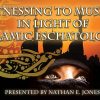Pope Benedict XVI shocked the world on February 11 when he suddenly announced that he would retire on February 28 due to deteriorating health. There had not been a papal resignation since 1415 when Gregory XII stepped aside as part of a controversial arrangement to end the Great Western Schism among competing papal claimants. Benedict became the first Pope in history to resign due to health reasons.
The Pope’s resignation created a sensation among Bible prophecy buffs because of a widespread belief that he would be the next-to-the-last Pope. This belief is grounded in what is called “The Prophecy of the Popes,” a document consisting of 112 short, cryptic phrases in Latin, which claims to predict all the Popes that would succeed Pope Celestine II who died in 1144.
A Strange Document of Unknown Origin
The document became public in 1595 when a Catholic priest by the name of Arnold de Wyon published a history of the Benedictine Order. He attributed the prophecies to an Irish priest, Saint Malachy, who served as an Archbishop in the 12th Century.
According to the traditional account, Malachy was summoned to Rome in 1139 by Pope Innocent II, and while he was there, he supposedly received a vision of future Popes. The manuscript was deposited in the Vatican Archives and forgotten about until its rediscovery in 1590, just in time for a papal conclave that was in session at the time.
The “prophecies” list 112 Popes that will serve from the time of Pope Urban VII who died in 1590, the first being Pope Gregory XIV whose papacy lasted for only one year. The last Pope in the list is referred to as “Peter the Roman.” And it is stated that he will reign among “many tribulations” leading up to the destruction of Rome.
Problems With the Document
There are a number of problems with these “prophecies,” as outlined below.
1) Unknown before their publication in 1595. Saint Bernard of Clairvoux, who was a contemporary of Saint Malachy, never mentions the prophecies in his biography of Malachy, nor are they mentioned in any record prior to 1595.
2) Obtuse wording. The “prophecies” are as obtuse as the so-called prophecies of Nostradamus. They simply list a short phrase for each Pope. Examples are: “pig in a sieve,” “from cattle country,” “star of the swans,” “snaky man,” and “woodpecker between food.”
For the first 74 Popes in the list leading up to 1590 when the document supposedly was found, the discoverer, Arnold de Wyon, tried to make a match between the identifying phrase and the person who actually became the Pope described by the phrase. Thus, the phrase, “from the guardian goose,” supposedly pointed to Pope Alexander III (1159 – 1181) whose family’s coat of arms featured a goose. Many of Wyon’s explanations are terribly stretched and amount to what might be called shoehorning, but the matches are more tenable than the “prophecies” concerning those who were to serve as Popes after the document was made public in 1595, clearly indicating that the document was actually written around the time it was “found.”
The “prophecies” dating after 1590 are very difficult to match up with the Pope who supposedly fulfilled the prophecy. For example, the prophecy “country animal” ended up pointing to Pope Benedict XIV (1740-1758). Proponents of the prophecies have been able to link this “prophecy” to the Pope in only one absurd way — by arguing that he was a man of “plodding ox diligence.”
3) Questionable counting. From the time of the first Pope on the list to Benedict XVI, there were a total of 100 Popes. The only way to get the list up to 111 is to count the 11 men who served as Anti-Popes but who were never recognized by the Vatican as true Popes.
The Validity of the Document
Most experts who have studied the document carefully have concluded that it was manufactured by Arnold de Wyon as a propaganda piece to ensure that his candidate for the papacy in 1590 would be elected. Thus, the prophecy for Urban VII’s successor read, “from the old city.” The man Wyon favored was Cardinal Girolani Simoncelli who was from a city whose Latin name meant “old city.”
The ploy did not work. A man named Niccolo Sfondrati was elected, and he took the papal name of Gregory XIV. There was nothing in his background that linked him to the “prophecy” that stated he would be “from the old city.”
However, proponents of the “prophecies” argue that Gregory XIV’s father was a senator from Milan, and that the word, senator, is derived from the Latin word, senex, which means “old man.” Alternatively, they argue that Milan is the “old city” referred to. Again, an example of twisting a “prophecy” to mean virtually anything.
The New Pope
Although the newly elected Pope is from Argentina, he is not an Hispanic. He is of Roman descent, having been born of Italian immigrants to Argentina, but his birth name was not Peter, nor did he select that as his papal name. He does not fulfill the “prophecy” about him. Still, he could well prove to be the last Pope because the signs of the times clearly point to the imminent return of Jesus.
The only prophecies we need to pay attention to are those contained in God’s Word, for He is the only one who truly knows the future.
For I am God, and there is no other;
I am God, and there is no one like Me,
Declaring the end from the beginning,
And from ancient times things which have not been done,
Saying, “My purpose will be established,
And I will accomplish all My good pleasure”…
Truly I have spoken; truly I will bring it to pass.
I have planned it, surely I will do it.
– Isaiah 46:9b-11







I agree with you that Mallachi's prophecy is not very convincing. But what made me reconsider the fact that he may indeed be the last Pope, is the fact that he is a Jesuit. I have studied that sect rather thoroughly, and if there would be a man who would be cruel enough to destroy anyone who rejects the One World religion and the Anti Christ, it would be a Jesuit. Contrary to belief, the Jesuits still take the same oath of horrific violence today that they took throughout history, and woukd not hesitate to follow through if they felt they should. Check it out for yourself. I will be watching him very closely, as he no doubt will become the most popular and powerful Pope ever. Even many of the Evangelicals and Protestants will affilliate themselves in the near future, I am sure. God Blee you for a great Blog. Love that you do what you do for our Lord,
Elaine
I am always sceptical of these types of things, too, however, it is interesting that the new pope chose his new name from St. Francis of Assisi. St. Francis' real name was Giovanni di Pietro di Bernardone. Pietro is Peter. As you said, Dr. Reagan, the new pope is of Italian descent. Peter the Roman – Petrus Romanus – is not much of a stretch.
I am very glad someone with clout has finally said that the only prophecy we need to concern ourselves with is the Word of God. When I hear people keep pointing to an Islamic anti-Christ because the koran says there will be this leder it is somewhat frustrating that someone with clout doesn't point out that no prophecy from any other religion makes any difference if it is not written in the Bible.
Agreed about there being little possibility of a Muslim Antichrist. Lamb & Lion has these articles on the topic – here and here.